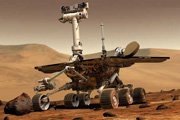News Categories
Shell & Desktop Enhancements
Links
| Rovers find organic compounds, but are they from Mars? |
| Tuesday, 25 December 2012 22:13 |
|
Alth The first soil samples taken by the rover and its Sample Analysis at Mars lab, or SAM overshadowed everything else at the meeting of the American Geophysical Union in San Francisco. The curiosity ran high as there were rumors that the Curiosity team was about to announce some major findings and in spite of NASA’s attempt for tempting down any such expectations, the scientists remained overjoyed with the initial analysis. At the American Geophysical Union briefing, Paul Mahaffy, the leading researcher and scientist of SAM announced that he considered the initial analysis as a terrific milestone. Mahaffy was further quoted by NASA’s jet propulsion laboratory in his statement that so far they didn’t discover any Martian organic compounds but looking for them in the diverse environments of Gale Crater. Curiosity rover has been studying Martian rocks, soil and atmosphere with the help of its suite of ten scientific instruments since it landed in Gale Crater on August 5. The primary mission of this two-year project with an estimated budget of $2.5 billion is to look for the weather conditions in the crater which could be favorable for microbial life. SAM is one of the key tools designed for the mission as it can heat the Martian samples in mini oven and provides analysis of the gases and identifies the compounds of the sample. The study of initial soil samples, collected during the several weeks from the drift of windblown sand called Rocknest, was also conducted using other instruments, including the Chemistry and Mineralogy instrument known as CheMin. NASA confirmed that the chemical composition of the samples collected through Rocknest and analyzed through CheMin was similar to samples collected by other missions such as Spirit, Pathfinder and Opportunity and consisted of about fifty percent of common volcanic materials and fifty percent non crystalline minerals, including glass. SAM analysis revealed that other ingredients were found in very low concentration and water molecules seemed to be apparently bound to the grains of sand and dust. The water concentration was higher than expected but not enough to support any life form. SAM confirmed the discovery of perchlorate by Phonix Mars Lander in 2008 by NASA. The toxic compound perchlorate includes chlorine and oxygen and used as the ingredient of rocket fuel. Scientists are hopeful that the compound could be an energy source for microbes on Mars. Mahaffy stated that it seemed that Curiosity detected calcium perchlorate, but they were still studying the compound.
The chlorinated methane compounds were also formed when compounds were put to reaction with the other chemicals in the SAM’s oven. These are considered by the geologist as the organic compounds as they contain carbon and hydrogen. Mahaffy explained, it was most likely that the chlorinated methane compounds were formed from some perchlorate like compound in the soil. However, it was not sure whether the traces of the carbon in the compound originated from the Martian soil or taken there by the Curiosity itself. He further highlighted that it is imperative to make sure that both these compounds the chlorine, and the carbon originates from the Mars. The project scientist for Curiosity mission, Caltech's John Grotzinger also repeated the view that they were still not sure that the compounds originated to the Red Planet or not. Grotzinger stated that the team would be challenged with the task to confirm that the organic compounds analyzed by SAM actually came from Mars, and if they did originate from Mars, they still have to confirm whether they are part of the planet’s chemical process or result from some background falls of the cosmic materials from space. The reconstruction of chemical compounds and confirming for truly Martian organic compounds will take a step by step process. Grotzinger explained that confirming Martian organic compounds involves complicated decision pathways, which need to be explored systematically. Once the reconstruction of the chemical compounds takes place, you have to decide whether the formations are abiotic or whether they lead to biologic elements. He further cautioned that there can be no hallelujah moment in the search of organic compounds on Mars. The rumors and expectations that an earth-shaking discovery could be revealed at the AGU meeting arose from one of the statements given by Grotzinger himself when he said that the data from Curiosity mission would find a place in the history books. NASA later clarified that Grotzinger was referring to the whole mission rather than any specific events or findings. |
 ough it is yet not confirmed that NASA’s Curiosity rover has discovered the organic compounds on the planet Mars, it has indicated that the soils of the Red Planet do contain water and complex chemicals that include the intriguing compound perchlorate.
ough it is yet not confirmed that NASA’s Curiosity rover has discovered the organic compounds on the planet Mars, it has indicated that the soils of the Red Planet do contain water and complex chemicals that include the intriguing compound perchlorate.